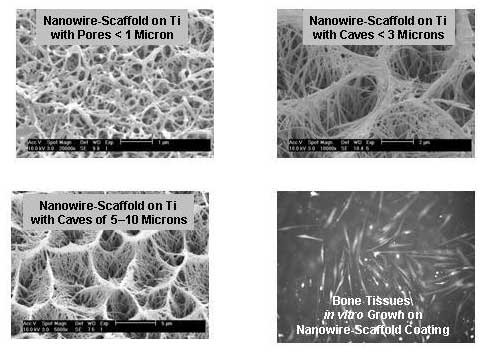SAFENANO launches nanotechnology health and safety website
A website providing information on nanotechnology health and safety is today being launched by SAFENANO.
Aug 21st, 2007
Read more
A website providing information on nanotechnology health and safety is today being launched by SAFENANO.
Aug 21st, 2007
Read moreJapanese researchers have developed a nanopipette that uses an organic nanotube as its nanochannel and which is estimated to be capable of dispensing volumes of solution of less than 1 femtoliter.
Aug 21st, 2007
Read more Researchers have found a simple, inexpensive way to create a nanowire coating on the surface of biocompatible titanium that can be used to create more effective surfaces for hip replacement, dental reconstruction and vascular stenting.
Researchers have found a simple, inexpensive way to create a nanowire coating on the surface of biocompatible titanium that can be used to create more effective surfaces for hip replacement, dental reconstruction and vascular stenting.
Aug 20th, 2007
Read morePlacing a film of silicon nanoparticles onto a silicon solar cell can boost power, reduce heat and prolong the cell�??s life, researchers now report.
Aug 20th, 2007
Read moreIn an effort to develop alternative energy sources such as fuel cells and solar fuel from "artificial" photosynthesis, scientists are taking a detailed look at electrons - the particles that set almost all chemical processes in motion.
Aug 20th, 2007
Read moreResearchers for the first time image hydrogen peroxide in animals.
Aug 20th, 2007
Read moreScientists have developed tiny, spherical nanogels that uniformly release encapsulated carbohydrate-based drugs.
Aug 20th, 2007
Read moreSmall nano-based biosensor may get help first to those who need it most.
Aug 19th, 2007
Read moreFive renowned chemists and inventors gather today to describe the challenges and opportunities for commercializing new technologies.
Aug 19th, 2007
Read moreNanotech BC has released the final draft of its Nanotechnology Asset Map. This Map is the most comprehensive view of the nanotechnology community in BC to date.
Aug 18th, 2007
Read moreThe University of Michigan Center for Risk Science and Communication just announced that registration is now open for the 2007 Bernstein Symposium: "Nanotechnology and Health: Evidence and Impact."
Aug 18th, 2007
Read moreNew findings bode well for using single-walled carbon nanohorns, a particular form of engineered carbon-based nanoparticles, for drug delivery and other commercial applications.
Aug 17th, 2007
Read moreResearchers have warned that growing biofuel crops to make eco-friendly car fuel could actually be harmful to the environment.
Aug 17th, 2007
Read moreNanoscopic bubbles with plastic membrane and built-in enzymes for multistep one-pot reactions.
Aug 17th, 2007
Read moreA conference next week in Greece "10th International Congress on Amino Acids and Proteins (ICAAP)" includes a symposium on "nanotechnology, neuroprotection and neurotoxicity".
Aug 16th, 2007
Read moreIs the U.S. losing its edge in nanotechnology?
Aug 16th, 2007
Read more